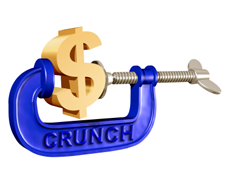Home Restaurant Free Restaurant Business Strategy Questionnaire 4.27 Annual Change in Consumer Prices Analysis Questionnaire
4.27 Annual Change in Consumer Prices Analysis Questionnaire
 Why do we need to look at the Rate of Change analysis for the CPI indices in this business plan for A Touch of Tuscany?
Why do we need to look at the Rate of Change analysis for the CPI indices in this business plan for A Touch of Tuscany?
The earlier analysis that we conducted looked at the absolute value of the CPI index for all goods and services in the metropolitan area in which a business like A Touch of Tuscany is located along with the industry specific CPI index. However being that we use only the value of both the indices we are only able to visually see what the slope is of both the lines and get a visual fix on what is happening with these costs - in addition to that visual we also need to be know precisely what is the rate of change in prices of a the Consumer Price Index (CPI) - this is the hard number that measures the difference between the prices of a fixed basket of goods and services over time and this number is the key statistic that is used by business owners to understand the nature of price increases locally.
Is the Rate of change in the CPI, the same number that we hear about on TV and print?
Yes. Most media sources report the rate of changes in the CPI index as opposed to the index values themselves, since telling someone the value does not give them the context they need to be able to ascertain what that value is in relation to the previous values. The rate of change analysis is what is needed to deliver that vital piece of strategic information to business owners like Jack Gordon and other readers of the business plan like bankers and potential partners.
How should the Rate of Change in the CPI analysis be interpreted by a small business owner like Jack Gordon?
The Rate of Change in the CPI analysis is presented in graphical format with the data tables which show the actual change serving as the data source. The key here for small business owners like Jack Gordon is to get a sense of just what the rate of change in the CPI indices have been over the past 10 years. To facilitate this, we have represented the two CPI Indices in the form of bar graphs and we compare the bars for the CPI index for all goods and services to the CPI index for the industry segment over 10 years. Thus when looking at the graph the reader of the business plan is able to see with clarity just which of the two indices have been leading the other. When we use the Rate of Change in the CPI analysis and compare that to the CPI Index analysis discussed in the previous section, a very clear picture begins to emerge about which CPI index is increasing at a more rapid pace.
Thus for example if you are in the Petroleum industry and have a gas station and see that the price of oil has been moving up from $40 per barrel to $80 per barrel, you will see a corresponding increase in the price of gasoline, and that of course means that you will also have to increase the prices for the gas that is being sold at your gas station. Thus when if you were to compare the rate of change analysis for the CPI of all goods and services in your metropolitan area, to the CPI for your industry, you will likely find that your industry CPI has been rising at a much higher rate than the regular CPI.
Again, what this means is after conducting the analysis you will be able to ascertain just how much more consumers are having to pay locally for your product compared to the remaining basket of services. The reason you need to know this is that you have to be very careful about pricing yourself out of the marketplace. Thus if you were to keep raising prices instead of absorbing the increased costs to you, it is very possible that you will loose some or a big chunk of your customer base since they may choose to go to the competition that is able to offer them better prices.
Why does the Rate of Change of the CPI index analysis have to cover a period of 10 years?
We strongly believe that the Rate of Change analysis for the CPI indices should cover a period of at least 10 years to get a clear understanding of the trend in the changes in the values of both the underlying indices being compared. As is well known, in the short run it is quite possible for there to be swings in the values of any economic metric or index, and so looking at any shorter period like say 3 years may indeed only give us a partial view into the true trend of prices over the duration of a decade.
What if the Rate of Change for CPI index analysis shows that the rate of change in the CPI for my industry is slower than the CPI for all goods and services?
In the event the Rate of Change for the CPI index for your industry segment is showing a slower rate of change than the CPI for all products and services, it could indicate that there is slowing demand for the goods and services being offered by your industry or that a new technology has been introduced that has reduced the prices of the goods and services. A good example of this is the price of computers - in the early nineties, the price of a computer adjusted for inflation was a lot more than it is today, and that is because significant improvements and advancements in technology along with stiff competition has resulted in the steady downward pressure on prices over the last 20 years. This applies to almost any new consumer electronic item as well - thus when the first plasma televisions came out they were very expensive but over time the cost of plasma televisions has gone done substantially and they have become very affordable. This is exactly how it works for industries as well. The music business has seen a tremendous decrease in profitability and margin compression due to the internet which has given independent artists the ability to reach the public directly.
As a business owner like Jack Gordon you have to be careful and understand that deflationary forces are at play in your particular industry, if the CPI for your industry segment does not keep up with the CPI for all goods and sevices. While falling or stalling prices may not always indicate deflation - you must be constantly mindful of the possiblility of deflation. The last thing you want to do is to get an increasingly larger share of a market that is on the decline. Don't forget - the last manufacturer that made buggy whips has a market share of 100%.
Quick Links:
- Go to the Corresponding Template section for this industry.
- Go to the Corresponding Business Plan section for this industry.
Small Business Owner Resource Center

Articles on the Small Business Financing Sources, the Small Business Loan Basics, small business loans Checklist and SBA Loans are incredible sources of knowledge for the small business owner.

Credit Report and Credit Score Analysis, how to Read a Personal Credit Report and all about Business Credit cover the intricacies of credit and are required reading for everybody.

The Foundation Grant Directory is a free listing of sources for grants by state. Why not look if there is some free money out there for your business. Hey - you never know!

The Business Loan Application covers every item you will need in your loan package and tells you how to get approved for business loans.

Fire your loan broker and use our Free Business Loans Bank / Lender Directory to find every bank in the country lending to small businesses.

If you are looking to start a business - look no further. Check out the Free Incorporation Guide discussion and the State Incorporation Resource Directory.




